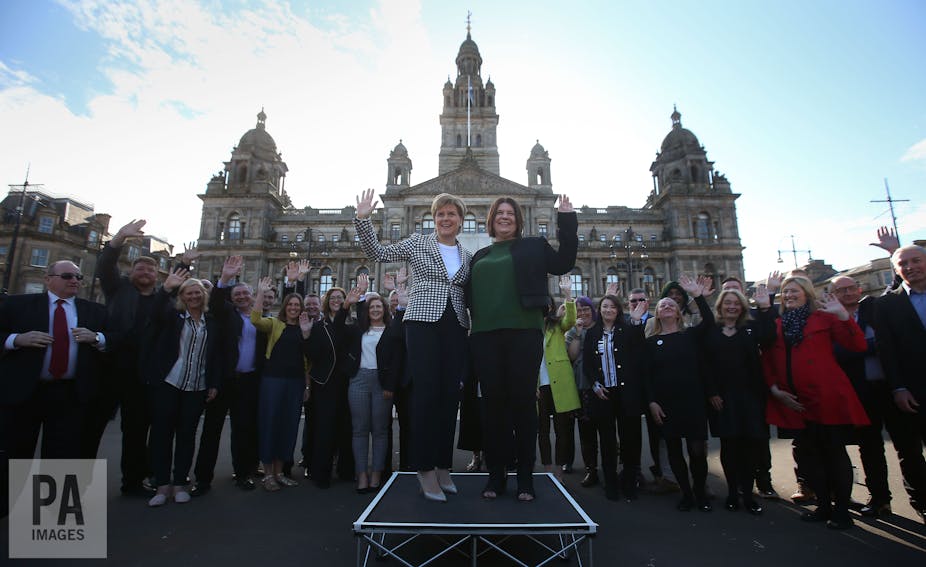At first glance the SNP scored another remarkable success in the Scottish local elections on May 4. The party won 431 seats, 155 more than their nearest rivals, the Conservatives. Meanwhile, Labour, who once dominated local government in Scotland, were even further behind.
Equally, the official tally of the parties’ share of the first preference vote across Scotland as a whole, which has just been published, confirms that the party was well ahead of the rest of the pack. The SNP won 32.3% of the vote, while the Conservatives secured 25.2% and Labour 20.2%. Both the Liberal Democrats (6.8%) and the Greens (4.1%) were even further behind.
Yet the task facing the SNP next month is to defend its remarkable success in winning 56 out of Scotland’s 59 seats at the UK election in 2015, a success based not on winning a little less than a third of the vote, but on securing 50%. The fact that the party won only 32% in the local elections would seem to raise questions about its ability to repeat that feat.
In truth, the two figures are not directly comparable. Over one in ten votes on May 4 were cast for independent candidates – in the Highlands and the Islands in particular, council elections are often still genuinely local rather than partisan battles. Independent candidates will not do that well in the general election.
But even if everyone who voted independent would have voted SNP in a general election (a highly improbable supposition), that clearly cannot account for all of the difference between the two performances.
The long five years
The share of the SNP’s first preference vote is actually exactly the same as five years ago, when the last round of these elections was held. Although that marked the first time that the SNP had managed to outpoll Labour in local elections, the outcome was, in truth, widely regarded as a disappointment for the nationalists. What was no more than a one-point lead over Labour had seemed like small beer after the SNP’s’ success on winning an overall majority at Holyrood a year earlier.

Still, that disappointment did not stop the SNP winning half the vote in the UK election in 2015, so perhaps it will not do so again. Maybe we are simply discovering that voters in Scotland are just not so keen on voting for the SNP in local elections – as was the case for Westminster elections until the party’s 2015 success.
But equally, it could be a sign that the party has lost ground. After all, three years – and an independence referendum – elapsed between the 2012 local elections and the 2015 UK election. And the SNP have not had any difficulty increasing their vote in local by-elections during the last two years. On average the party’s share of the vote has been up ten points on 2012 in such contests. That would suggest every good reason to think the SNP’s share of the vote would also have gone up this time around.
Grim up north-east
Meanwhile, although the SNP’s share of the first preference vote may have held steady across Scotland as a whole as compared with 2012, it has not held up everywhere. It has fallen heavily in much of the north-east in particular. It is down by 13 points in Angus, 11 in Aberdeenshire, nine in Perth, and eight in Moray.

At the same time, the Conservatives have recorded some of their biggest increases in this area under Ruth Davidson: the party’s vote was up by 19 points in both Aberdeenshire and Moray, and 16 points in both Angus and Perth. As a result, it could present a particularly strong challenge to the SNP in such key seats as Moray, currently held by Angus Robertson, and Perth, where the incumbent is Pete Wishart.
Of course, these losses of support in the north-east were counterbalanced by gains elsewhere. The SNP’s success in ending Labour’s control of Glasgow City Council was matched by an eight-point increase in support across the city. Elsewhere in the west of Scotland the party’s vote also increased – especially sharply in West Dunbartonshire (up ten points), and in Inverclyde (up seven).
All in all, there is little in these local election results to suggest that Labour is on course to reverse the losses it suffered at the hands of the SNP in its Clydeside heartland two years ago. But in contrast to 2015, it is no longer Labour who the SNP have most reason to worry about.

